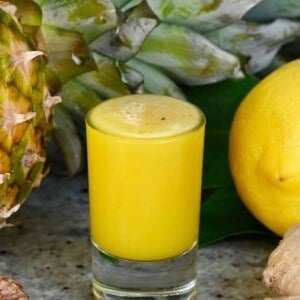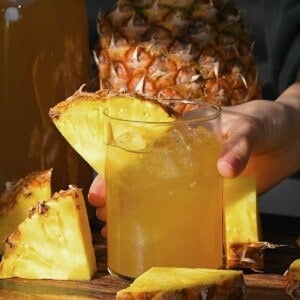This post may contain affiliate links. Please read our disclosure policy.
This pineapple skin tea mixes pineapple peel, ginger, turmeric, and cinnamon for a tasty, anti-inflammatory drink that helps digestion. Sweetened with honey, it’s a perfect health boost!

I love reducing food waste, and this pineapple tea recipe is a favorite! Inspired by a traditional Jamaican drink, it combines pineapple peels, ginger, and orange or lemon juice for a warming and delicious tea.
Plus, this pineapple skin tea is excellent for your health because pineapple, including its peel and core, contains bromelain, a protein-digesting enzyme with anti-inflammatory benefits. Rich in vitamin C, it aids digestion, making this amazing drink perfect for any time of the year.

While it’s refreshing served over ice in the summer, I always make sure to sip on a hot cup of pineapple tea whenever I feel a cold coming on. It’s one of my favorite natural remedies, along with these lemon, ginger and cayenne immunity shots and turmeric ginger energy shots.
Want to save this recipe?
Watch the recipe video tutorial
Ingredients
While there are variations of the tea, here is my favorite ingredient combo. I have carefully chosen these ingredients for their flavor and health benefits.

- Pineapple peel: Use the core, too, for even more bromelain
- Orange and lemon: Make sure to use fresh orange and lemon juice. You can use a regular orange or even blood orange.
- Aromatics: Ginger and turmeric. I prefer to use fresh rather than powdered, so you don’t end up with the ground spice’s sediment in the liquid.
- Spices & Herbs: Cinnamon sticks, cayenne or black pepper (optional, to help curcumin absorption), and rosemary. You can experiment with other herbs that pair well with pineapple, such as mint, lemon basil, basil, sage, etc.
- Sweetener: I sweetened it with honey after making the tea. You could use maple syrup, or not add a sweetener at all.
How to make pineapple skin tea
Clean the pineapple: It’s essential to clean the pineapple skin thoroughly. Scrub the pineapple thoroughly with a vegetable brush. I like to do a vinegar soak (optionally adding salt as well) to help remove bacteria and pesticides from the skin. Fill a large pot with enough water to submerge the pineapple body and add 1-2 Tbsp of vinegar (and optionally 1 Tbsp salt) – this shouldn’t affect the pineapple’s flavor. Allow it to soak for 20-30 minutes, then rinse well with clean water.
Peel the skin: Pat the rinsed pineapple dry and then remove the peel with a sharp paring knife. You can also use the pineapple core. The pineapple flesh can be eaten as a snack or stored in the fridge/freezer to make smoothies.

Simmer the ingredients: Juice the lemon and oranges, then combine all the ingredients (excluding the honey) in a large pot with water. Heat over medium heat until it reaches a boil, then reduce the heat and let it simmer for one hour. The longer it simmers, the more flavorful the tea will become.

Strain: Allow the tea to cool down slightly before you sieve it and transfer it to bottles.

You can add a little sweetener now (I used honey), or just before serving it, or omit this entirely. The pineapple peel tea is then ready to drink immediately or store for later. You can enjoy the anti-inflammatory warm or cold. It can be enjoyed alone or added to other drinks, including lemonade and cocktails, in place of pineapple juice.

Tips for pineapple peel tea
- Make sure to thoroughly wash the pineapple before using the pineapple skin.
- You can collect pineapple scraps in a bag in the freezer until you’re ready to make a batch of this pineapple skin tea.
- Add a pinch of black pepper to each serving of the tea (you won’t taste it). This helps our bodies fully absorb the turmeric nutrients.
- Bromelain, found in the pineapple peel and core, can interact with medications like anticoagulants and antibiotics. Consult a doctor before drinking pineapple tea if you are on any medications.
How to store
- Fridge: I like to keep my pineapple skin tea in a bottle with a tight seal to keep it fresh. You can also use airtight glass containers to store it in the fridge for up to 10 days—just be sure to avoid any staining!
- Freeze: The tea can also be frozen into ice cubes to add to drinks or thaw and consume.

How to use the leftover pulp?
There’s no need to discard the leftover pulp. You can use it in several ways. First, remove the rosemary sprigs and cinnamon sticks. Then:
- Make juice: After brewing the tea, the pineapple pieces should still have plenty of flavor. Add the pulp to a blender with some water and blend. Then, sieve the mixture to make juice.
- Or blend into pulp: Blend the pineapple peel, ginger, and turmeric into a pulpy mush. This can be frozen into ice cubes and then used in smoothies, added to marinades, or made into a single portion of hot tea.

More refreshing pineapple drinks
If you try this pineapple skin tea recipe, let me know how it goes in the comments below. I’d appreciate a recipe card rating and would love to see your recipe recreations – tag me on Instagram @Alphafoodie!

Best Pineapple Skin Tea
Ingredients
- 17 cups water
- 1 pineapple large, the peel and core
- 2 oranges any variety
- 1 lemon
- 2 Tbsp turmeric grated
- 3 Tbsp ginger grated
- 2 sprigs rosemary or thyme, basil, lemon thyme, etc.
- 2 cinnamon sticks
- 1/2 tsp Cayenne pepper or fresh black pepper (for absorbing turmeric nutrients)
- 3 Tbsp honey Optional, can be added in teaspoons when serving the tea; OR maple syrup
Instructions
Prepare the ingredients
- Scrub the pineapple thoroughly with a vegetable brush. Optionally, do a vinegar soak. Fill a large pot with enough water to submerge the pineapple and add 1-2 Tbsp of vinegar (and optionally add 1 Tbsp salt). Soak for 20-30 minutes, then rinse well with clean water.
- Pat the rinsed pineapple dry and then remove the peel with a sharp paring knife. You can also use the pineapple core.
- Juice the lemon and oranges.
Make the tea
- Pour the water into a large pot. Add the pineapple skin, grated ginger and turmeric, lemon and orange juice, rosemary sprigs, cinnamon sticks, and pepper. Bring to a boil over medium heat, then simmer for about 1 hour—the longer it simmers, the more flavorful it will become.
- Let the tea cool slightly, then sieve it and transfer it to clean glass bottles.
- The tea is ready to drink immediately or store for later. Optionally, add a little sweetener now or just before serving. Serve warm or cold.
Video
Notes
Nutrition
Nutrition information is automatically calculated, so should only be used as an approximation.













Delicious and warming for winter! The cayenne reminds me of the zing you get from Mayan Eyes hot chocolate. Thank you for your practical and healthy-feeling recipe.
Thank you for your comment, Pam 🙂
To reap the benefits of this drink. Can this drink be consumed everyday or once a month. Like anything, too much of something is not good for you.
Hi Peggy,
You can consume it daily.
1/2 teaspoon of cayenne made the tea WAY too spicy.
Thank you for the feedback. Please feel free to adjust the amount to your liking.
Hi! I am making this tea tomorrow – what exactly do I do with the oranges? Peel them and put the orange segments in there? Put them in whole with the peel?
Hi Kristin,
The oranges and lemon are juiced. Then their juice is brewed with the rest of the ingredients.
I cut the oranges in half. Squeeze as much juice as I can into the pot of water with the pineapple skin the pineapple skin and then I dropped the whole Orange into the pot of water and boil it with the skin.
Great tips. Thanks, Elise!
Delicious! How often and how much should be consumed daily?
Thanks, Kay! You can enjoy one serving a day.
I love the recipe! I like to boil the pineapple skin and add couple green tea bags as my morning boost and now this recipe is my afternoon relaxing, thanks
Thanks for sharing. This sounds delicious.
Could this recipe be canned then?
Hi Amber,
Yes, you can seal and pasteurize it to preserve it for longer.
Hi, can I used Turmeric powder for this? And how much? I don’t have fresh Turmeric 🙁
Hi Yasmin,
You can omit the turmeric or use about 1 Tbsp turmeric powder. 🙂
Fresh tumeric is easy to find in the grocery store
Thanks for your comment, Elise.
I made this the other night and not as bad as I thought it would be. It’s a keeper. How many cups should one drink a day to be effective for gut cleaning?
Hi Celena,
I’m glad you liked it. One serving (cup) a day would be sufficient, that is if you manage to only stick to one a day 😉
I made it yesterday and it is so delicious! It is also a great idea in order not to waste the pineapple cores.
Thank you alot for the recipe.
Thank you so much for your comment, Ayna. Glat you tried and liked this recipe 🙂
I don’t put all those ingredients. Every morning I have fruit for breakfast. I have a slice of pineapple with my fruits. I don’t peel the whole pineapple at once. I just cut a slice and put the peel from the slice in an insulated cup along with some cinnamon. I just fill the cup with boiling water, cover and leave it. Then at night for dinner, I just strain and drink without any other additions.
Thank you for your comment, Cher. This is a great “hack”. Alternatively, you can keep the peel in the freezer until you have enough to make a big batch of the tea if wanted.
The cayenne pepper is very strong. I feel it on my throat. What did I do wrong?
Hi there,
If the cayenne pepper is too strong for you, you can always decrease the amount – use 1/4 or even 1/8 tsp. Or try black pepper the next time you make it.
I hope you give it another try! 🙂
Very delicious. I grew up drinking this drink without knowing the health benefits of the pineapple skin.
We didn’t know about turmeric at that time so we made it with cinnamon and cloves.
There are so many things we still need to learn. 🙂 I’m glad you liked it, Shelby.
How often is this supposed to be consumed to cleanse the body?
Hi Donna,
You can consume it daily.
Interesting ! Would love to try them soon.
Thank you, Fae. I hope you give this recipe a try soon.
Want to try this. Can powder tumeric be used if don’t have any fresh? Also, lemon juice if no lemon?
Thanks!
It’s best to use fresh turmeric and freshly squeezed lemon juice. If not available, you can use about 1 Tbsp turmeric powder and 3 Tbsp lemon juice. I hope this helps.
I now buy the pineapple for the skin and eventually eat the fruit as well. Super recipe! Made it at least 15 times. I also plant the top of the pineapple afterwards. It’s addictive
Thank you so much for your comment, Soph! So happy you are enjoying the recipe!
How often should I drink this? Every day ?
Hi Nelda,
Yes, you can drink it every day if wanted.